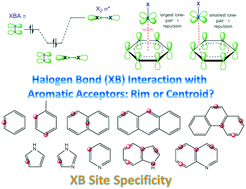当前位置:
X-MOL 学术
›
Phys. Chem. Chem. Phys.
›
论文详情
Our official English website, www.x-mol.net, welcomes your feedback! (Note: you will need to create a separate account there.)
Site specificity of halogen bonding involving aromatic acceptors†
Physical Chemistry Chemical Physics ( IF 3.3 ) Pub Date : 2018-02-23 00:00:00 , DOI: 10.1039/c7cp08343b Shi Jun Ang 1, 2, 3, 4, 5 , Adrian M. Mak 4, 5, 6 , Michael B. Sullivan 4, 5, 6, 7, 8 , Ming Wah Wong 1, 2, 3, 4, 7
Physical Chemistry Chemical Physics ( IF 3.3 ) Pub Date : 2018-02-23 00:00:00 , DOI: 10.1039/c7cp08343b Shi Jun Ang 1, 2, 3, 4, 5 , Adrian M. Mak 4, 5, 6 , Michael B. Sullivan 4, 5, 6, 7, 8 , Ming Wah Wong 1, 2, 3, 4, 7
Affiliation

|
Halogen bonding (XB) has become one of the most studied non-covalent interactions in the past two decades, owing to its wide range of applications in materials and biological applications. Most of the current theoretical and experimental studies focus on XB involving lone-pair acceptors due to its predictability in terms of crystal geometries. However, recent reports have advocated the importance of XB materials involving aromatic-type acceptors because of their relevance in functional materials, catalysis and biological systems. Herein, we report the XB site-specificity in several polycyclic aromatic hydrocarbons (PAHs) and N-heteroaromatic compounds that are ubiquitous in chemical systems. Based on a series of quantum chemical studies of Cl2 and Br2 XB complexes with 14 representative systems, these XB sites can be easily predicted using occupied molecular orbitals and atomic charges. We envisage that the predicted site maps will be useful for materials and drug design involving this class of non-covalent interactions.
中文翻译:

涉及芳族受体的卤素键的位点特异性†
卤素键(XB)由于其在材料和生物学应用中的广泛应用,在过去的二十年中已成为研究最多的非共价相互作用之一。由于其在晶体几何结构方面的可预测性,当前大多数的理论和实验研究都集中在涉及孤对受体的XB上。然而,最近的报道提倡涉及芳香族受体的XB材料的重要性,因为它们与功能材料,催化作用和生物系统有关。在这里,我们报告了在化学系统中普遍存在的几种多环芳烃(PAHs)和N-杂芳族化合物中的XB位点特异性。基于对Cl 2和Br 2的一系列量子化学研究XB具有14个代表性系统的复合物,这些XB位置可使用占据的分子轨道和原子电荷轻松预测。我们设想,预测的站点地图将对涉及此类非共价相互作用的材料和药物设计有用。
更新日期:2018-02-23
中文翻译:

涉及芳族受体的卤素键的位点特异性†
卤素键(XB)由于其在材料和生物学应用中的广泛应用,在过去的二十年中已成为研究最多的非共价相互作用之一。由于其在晶体几何结构方面的可预测性,当前大多数的理论和实验研究都集中在涉及孤对受体的XB上。然而,最近的报道提倡涉及芳香族受体的XB材料的重要性,因为它们与功能材料,催化作用和生物系统有关。在这里,我们报告了在化学系统中普遍存在的几种多环芳烃(PAHs)和N-杂芳族化合物中的XB位点特异性。基于对Cl 2和Br 2的一系列量子化学研究XB具有14个代表性系统的复合物,这些XB位置可使用占据的分子轨道和原子电荷轻松预测。我们设想,预测的站点地图将对涉及此类非共价相互作用的材料和药物设计有用。



























 京公网安备 11010802027423号
京公网安备 11010802027423号